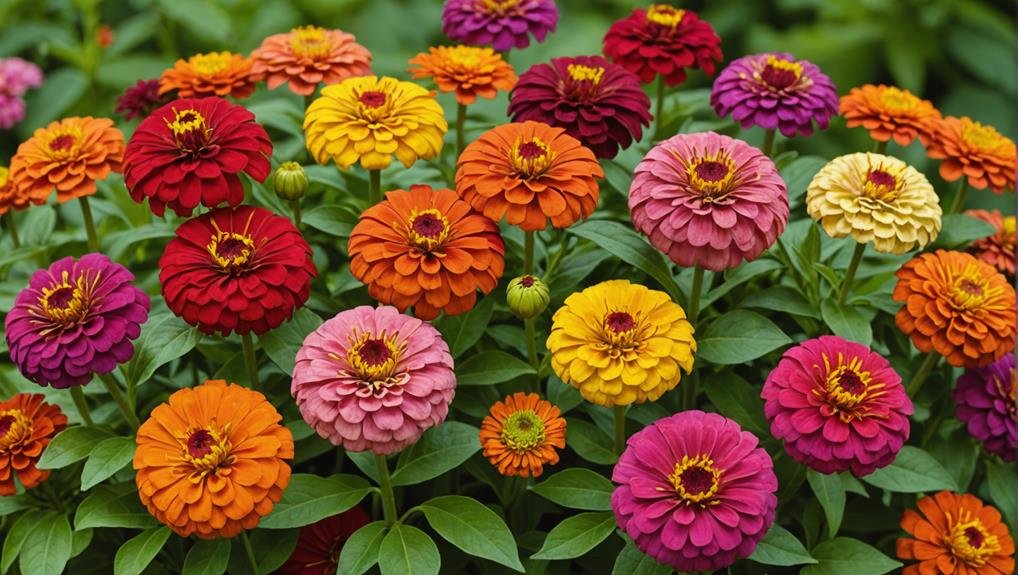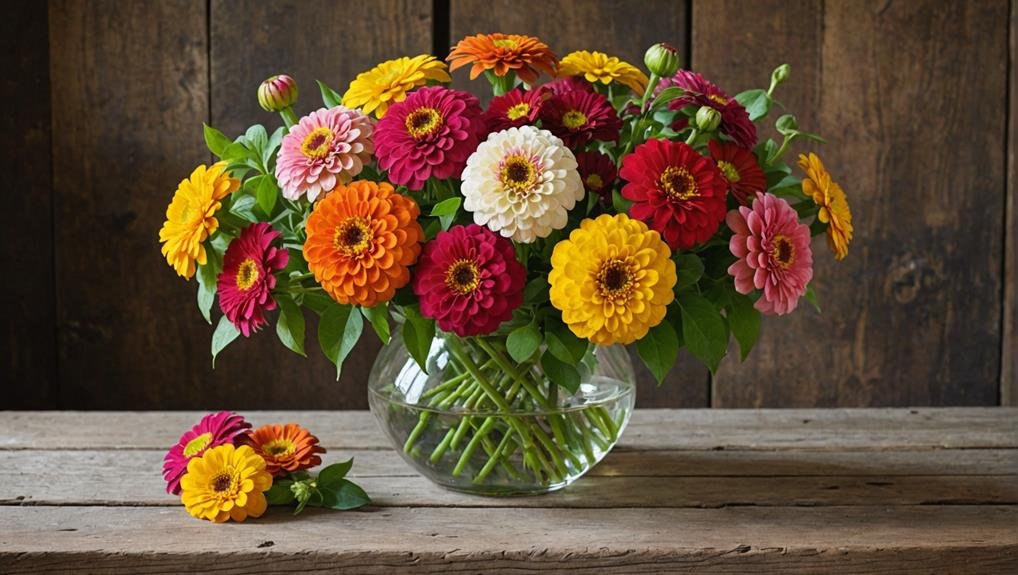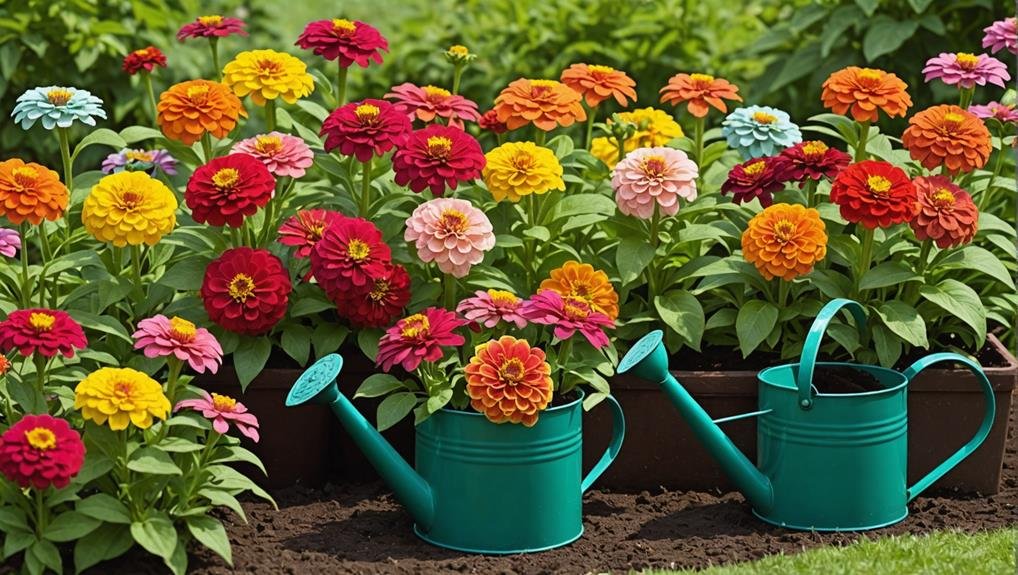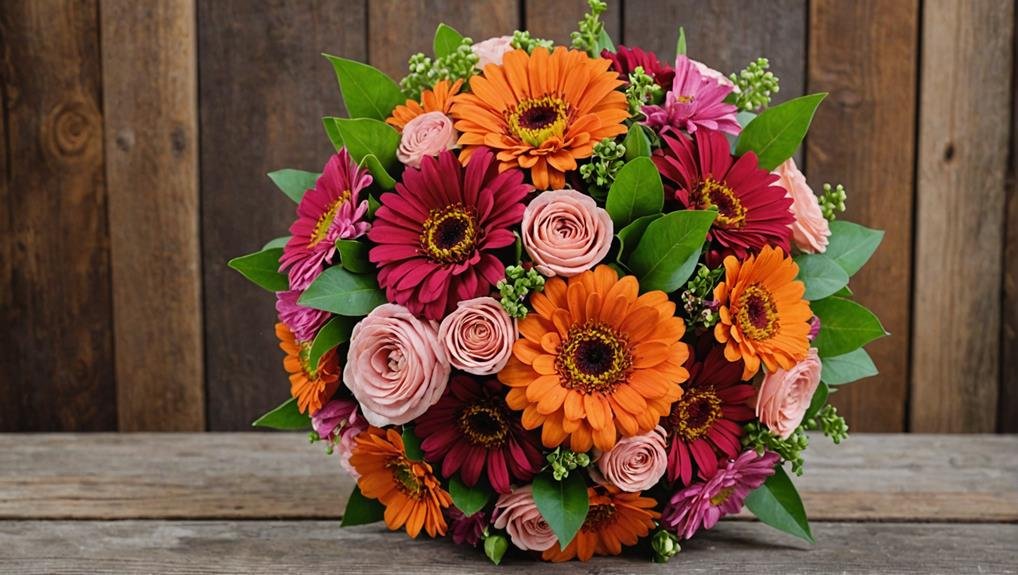When selecting floral arrangements for a wedding, the Zinnia offers a compelling choice due to its vibrant hues and versatile shapes. This flower’s extensive color palette and long-lasting nature make it perfect for both bouquets and centerpieces. Moreover, Zinnias carry significant symbolism, representing friendship, remembrance, and resilience. Of particular interest is the Queen Lime Orange variety, which adds a unique touch to any arrangement. As we explore the physical characteristics, cultural significance, and best growing conditions of Zinnias, the reasons behind their popularity in wedding florals become increasingly evident.
Flower Overview

Zinnias, originating from Mexico, are vibrant and easy-to-grow flowers popular among both novice and seasoned gardeners. Their popularity stems from their vivid colors and straightforward cultivation requirements, making them a staple in many gardens. With their ease of growth, zinnias serve as an excellent introduction to cut flower gardening, offering a gratifying experience with minimal effort.
A significant advantage of zinnias in floral design is the wide variety of zinnias available. This diversity allows for the creation of visually stunning arrangements suitable for various events, including weddings. Popular varieties such as the Queen Lime and Oklahoma series offer distinctive color palettes and petal structures, enhancing the aesthetic appeal of floral designs. The array of options guarantees that there is a zinnia to complement any theme or color scheme.
Furthermore, zinnias’ ease of cultivation makes them an appealing option for those looking to grow their own wedding flowers. They thrive in a range of conditions and require only basic care, such as regular cutting or deadheading, to promote continuous blooming. This simplicity allows even novice gardeners to produce ample, vibrant blooms ideal for local markets and wedding arrangements.
Physical Description
Bursting with vibrant hues, these annual flowers exhibit a wide array of forms and sizes, making them a versatile choice for both garden and floral designs. Zinnias are known for their striking single or double blooms, which are supported by long, sturdy stems. These stems make them ideal for cutting and arranging in various floral creations, from simple bouquets to elaborate wedding centerpieces.
Zinnias vary greatly in size, with some compact dwarf varieties growing only a few inches tall, while others can reach up to 3 feet in height. This range in stature provides flexibility for different design needs, whether you’re aiming for an elegant arrangement or a more casual garden look.
The flowers themselves come in different shapes, including the dahlia-flowered type, which features large, lush petals; the cactus form, characterized by its spiky, elongated petals; and the pompom variety, known for its rounded, full blooms.
In addition to their aesthetic appeal, zinnias are also practical for gardeners. They are known to attract butterflies and other beneficial insects, adding ecological value to their beauty. Grow Gorgeous Zinnias to enhance both your garden and your floral arrangements with their diverse and charming presence.
Available Colour Varieties

One of the most appealing aspects of zinnias is their extensive range of vibrant color varieties, which can effortlessly complement any wedding theme or decor. Zinnias are available in an impressive spectrum of colors, including pink, red, yellow, orange, purple, and white. This wide array guarantees that whether the wedding theme leans towards bold, bright hues or soft, pastel tones, there is a zinnia color to match.
Popular color varieties of zinnias include cherry red, golden yellow, lilac, salmon, and deep purple, providing ample options for creating eye-catching floral arrangements. Beyond these solid colors, zinnias also offer unique bi-color combinations that add an extra layer of visual interest. Notable bi-color combinations include lime green and purple, coral and cream, and red and yellow, each bringing a distinctive flair to wedding bouquets and centerpieces.
With over 20 different color varieties, zinnias present endless possibilities for enhancing the aesthetic appeal of wedding decorations. Their versatility in color makes them an ideal choice for florists and brides looking to create personalized, stunning floral displays that cater to any wedding style or palette.
Latin Name and Taxonomy
Belonging to the genus Zinnia within the Asteraceae family, the botanical classification of zinnias highlights their elegance and beauty as denoted by their Latin name, Zinnia elegans. This name aptly captures the essence of these flowering plants, which are celebrated for their vibrant appearances and graceful forms. The Asteraceae family, also known as the daisy or sunflower family, encompasses a diverse group of flowering plants, and zinnias are a remarkable member of this classification.
The taxonomy of Zinnia elegans is both intricate and fascinating, encompassing various species and cultivars. Each variant within this taxonomy is distinguished by unique traits, ranging from different flower sizes and forms to a spectrum of vivid colors. These characteristics make zinnias a versatile choice for various horticultural and decorative applications, including wedding arrangements.
Zinnias are classified as dicotyledonous flowering plants, with their structural attributes contributing to their long-lasting blooms and popularity in garden settings. The genus Zinnia includes several species, but Zinnia elegans stands out due to its widespread cultivation and aesthetic appeal.
Understanding the taxonomy of these plants provides valuable insights for florists and gardeners aiming to incorporate their timeless beauty into wedding decor.
Geographical Origins

Understanding the geographical origins of zinnias enhances our appreciation of their historical and cultural significance, especially given their native roots in Mexico where they were initially cultivated by the Aztecs. These vibrant flowers, known for their wide range of colors and hardy nature, have a rich history that dates back to ancient civilizations.
The Aztecs valued zinnias not only for their beauty but also for their practical uses in various ceremonies and daily life. Zinnias have since adapted well to various regions globally, particularly thriving in warm climates with full sun and well-draining soil. Their geographical origins in the temperate climates of Mexico have endowed them with characteristics that make them suitable for diverse environmental conditions.
Here are three key points about the geographical origins of zinnias:
- Native Habitat: Zinnias originated in Mexico, where they were cultivated by the Aztecs.
- Global Adaptation: These flowers have successfully adapted to different regions around the world, especially those with similar warm climates.
- Care Requirements: Understanding their native habitat helps in providing ideal growing conditions, such as protection from frost and attention to soil drainage.
Season Availability
Zinnias reach their highest blooming season during the warm summer and early autumn months, making them perfect for lively floral arrangements at weddings and events. Their presence during these months guarantees that they can be prominently showcased in various settings, from bouquets to centerpieces, adding a burst of color and sophistication. Zinnias, like the popular Queen Red Lime and Benary Giants varieties, are highly sought after for their vibrant hues and sturdy blooms.
These flowers thrive in warm weather with ample sunlight, making them a dependable choice for summer and early autumn events. Whether cultivated from seeds or bought as young plants from nurseries, zinnias are accessible and adaptable, offering a wide array of colors to match different aesthetic preferences.
| Season | Availability |
|---|---|
| Spring | Limited |
| Early Summer | High |
| Midsummer | Peak |
| Early Autumn | Peak |
The peak presence of zinnias during midsummer and early autumn not only guarantees their vibrant display but also aligns perfectly with the wedding season. This makes growing zinnias a pragmatic and exquisite choice for those organizing wedding celebrations during these months. Their diverse varieties, such as the exquisite Queen Red Lime and the majestic Benary Giants, offer endless opportunities for crafting stunning floral arrangements.
Growing Conditions

While their peak availability makes zinnias a favored choice for summer and autumn weddings, ensuring ideal growing conditions is key to achieving their vibrant blooms. Zinnias thrive best when grown in full sun and well-draining soil. Proper spacing is essential; plant zinnias 6-9 inches apart to facilitate air circulation, which helps minimize the risk of diseases.
To achieve the best stem lengths and healthy blooms, consider the following growing guidelines:
- Direct Sow: Zinnias are best planted directly in the garden soil. Start sowing after the danger of frost has passed, as these plants are highly frost-sensitive.
- Sunlight Requirements: Make sure that zinnias receive full sun exposure, which is approximately six to eight hours of direct sunlight daily. Insufficient sunlight can lead to leggy growth and reduced flowering.
- Pest Management: Be vigilant against common pests such as earwigs, beetles, aphids, and mites. Regular monitoring and appropriate pest control measures can help maintain the health of your zinnia plants.
Additionally, it is vital to note that zinnias do not store well below 45°F. Hence, harvest them promptly and use them quickly in arrangements to maintain their freshness and vibrancy for wedding decor.
Cultural Significance
In many cultures, zinnias hold profound meanings, symbolizing friendship, remembrance, and resilience, making them a significant choice for wedding floral arrangements. Their vibrant hues and diverse varieties, such as the Queen Lime series, contribute to their popularity. The Queen Lime Orange zinnias, part of this series, are particularly admired for their unique color gradient, adding an elegant touch to any bouquet.
The cultural significance of zinnias extends beyond mere decoration. Representing lasting affection and the strength of relationships, these flowers are often chosen to convey heartfelt emotions in significant life events. Their long vase life of about 5 days ensures that they remain fresh and beautiful throughout wedding celebrations, enhancing their appeal.
Below is a concise overview of the cultural meanings associated with zinnias:
| Symbolism | Significance | Varieties |
|---|---|---|
| Friendship | Celebrates lasting bonds | Queen Lime Orange |
| Remembrance | Honors past memories | Queen series |
| Resilience | Represents strength | Gorgeous Zinnias |
Incorporating zinnias into wedding décor is a meaningful way to add depth to the event’s aesthetic. Their cultural richness, combined with their visual appeal, makes them a favorite among couples looking to symbolize their enduring commitment.
Typical Use in Weddings

Why are zinnias such a popular choice for wedding floral arrangements? Gorgeous Zinnias offer vibrant colors and a long vase life, typically lasting around five days, making them ideal for the dynamic nature of wedding events. Their symbolism of friendship, remembrance, and endurance adds a layer of meaningfulness to wedding decor, enhancing the emotional resonance of the celebration.
Zinnias are particularly favored in wedding bouquets and centerpieces due to their sturdy stems and vibrant hues. The Queen Lime series, known for its unique lime green and soft pastel shades, adds a touch of elegance and sophistication. However, zinnias are not recommended for corsages or boutonnieres, as their larger size and robust stems can be cumbersome to wear.
To maintain the freshness of zinnias in wedding arrangements, it is essential to ensure continuous access to water and limit their storage to no more than five days. Harvesting them early in the morning can yield longer stems, ideal for creating dramatic floral displays.
Here are three key points to keep in mind when using zinnias in weddings:
- Symbolic Meaning: Friendship, remembrance, and endurance.
- Optimal Usage: Bouquets and centerpieces, not corsages or boutonnieres.
- Maintenance: Maintain constant water access and limit storage to five days.
Incorporating zinnias into wedding arrangements brings both beauty and symbolic depth to the celebration.
Alternative Flower Types
Exploring alternative flower types to zinnias can enhance wedding floral arrangements by introducing diverse textures, colors, and forms. Dahlias are an excellent choice, offering a wide range of colors and sizes that can suit any wedding theme. Their intricate petal patterns and vibrant hues make them a standout addition to bouquets and centerpieces.
Sunflowers, with their bold and cheerful appearance, bring a touch of brightness and a rustic charm to wedding decor. Roses, a timeless classic in the world of floral design, are incredibly versatile and can be incorporated into various styles, from traditional to contemporary.
Peonies, known for their lush and romantic blooms, add a soft and elegant touch to any arrangement. Their voluminous petals create a sense of abundance and luxury. Ranunculus, with their delicate and intricate flowers, offer a refined and sophisticated look, perfect for adding detail and texture.
In flower farming, these alternatives to zinnias are popular for growing cut flowers, ensuring a steady supply for wedding florists. Mixing these diverse flower types can result in a visually appealing and dynamic wedding floral design, catering to a wide range of aesthetic preferences and themes.
